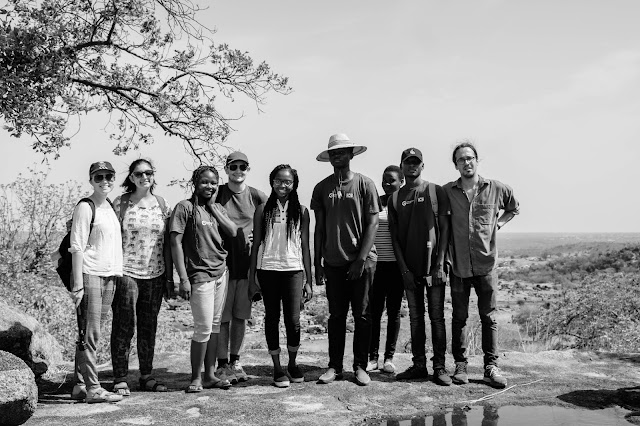Following Your Curiosity
Following Your Curiosity
Written by: Mamoon Khpal
Photos by: Mamoon Khpal
Edited by: Oliver Sage
Since arriving in Bolgatanga towards the end of April, the stifling heat has begun to give way to the Rainy Season. There is now a spring in the air surrounding the centre of town. Lush green pastures have replaced the sweeping desert sand which consumed us on our arrival, and the trees are blooming in equal measure. The large leaves from roadside trees are useful protection against bouts of heat or heavy rain appearing at the most inconvenient times. A few weeks ago I popped into Rain Inn Supermarket to collect a large pot of delicious Cowbell Coffee, and on the way home torrential rainfall struck me motionless beneath a tree. This was to the amusement of a few Yellow-Yellow drivers who asked between GHc 5-10 for the 10-minute walk home.
This chaos in Bolga has been no detriment to my tenacious curiosity. Of the places I discovered during my saunters, the most unique was The Bolgatanga Library. It was created by an award-winning American Architect, J. Max Bond Jr. (1935- 2009). He was awarded a degree in Architecture at Harvard University to pursue a career in the field. In the mid-1960s he moved to Ghana where he designed several government buildings, including the Bolgatanga Regional Library. It remains functioning but the state of it is deplorable. The centre contains rich shelves of books, and seating arrangements for bustling children and students. The fans overhead are still because the ventilation system inside the library keeps the occupants perfectly cool. Towards the entrance is a small chapel which stands empty and at the rear is an unusual concrete seating structure in the garden with faded scribbles and scratches vandals had made in the past. Like most good libraries, this one is enchanting and loved by those inside.
After losing track of time inside the empty rooms, I returned to the nave of the building and found the book I would be using for my guided learning session, ‘Faceless’ by Aama Darko.
 |
| Bolgatanga Regional Library |
The second outcome of my curious wanderings was discovering the Nongre Crafts and Culture Foundation. After an unsuccessful attempt with a disgruntled Yellow-Yellow driver unwilling to take me further than the timber market, I was referred to a smiley gentleman named Matthew who mentioned he knew the place. It was a 20-minute journey to the Foundation along a dirt road into the Nongre region, which my driver, Matthew, explained meant Love. The centre works with young children in the community outside school hours through traditional African dance, drumming, and handcrafts. The children are from families in the local community, and some I was told are orphans. The foundation wants to combat school dropout rates in the Upper East Region, by empowering basket weaving communities struggling to support their children. The open fields inside the area await development by the Foundation, which wants to build a school and library for the community.
 |
| Coffee at Nongre Crafts and Culture Foundation |
Sat inside the cafeteria at Nongre I recouped as much caffeine as I could afford. At 4 GHc a cup, I did not feel too guilty in gulping 5 portions down my throat. The cafeteria offers guests and volunteers Ghanaian and Ethiopian Coffee handsomely sealed for window display. The children took no hesitation in introducing themselves to me and posing for “snaps”. In their bright African wear they prepared themselves in two rows ready for performance. The procession of dancers led a cohort of boys drumming behind them onto the stage area. The young girls took ownership of the space very quickly breaking mounds of sand with their stomping feet. They moved with confidence and energy throughout the 40-minute performance and asked what I thought after. To say the least, I was swept away by the group. Hopefully, the photo can do it justice.
 |
| Nongre Cultural Group |
The final discovery I made during my curious rambles around Bolgatanga was at The Crafts Village. The village is surprisingly easy to find located behind the Catholic Church. Inside are shops selling high quality African Art and Crafts, and to the left of the village is the regional museum. The shop owners and crafts people inside the centre can often be seen busily designing leather, or weaving baskets. Among the treasure trove of items include British War medallions dating from Anglo-Ashanti wars during the 19th century. The shop owner tells me quite briefly that they have traveled to the Northern Region of Ghana for sale inside the shop. Alongside the antiques are coins from different national currencies grouped together inside a bowl reminding shoppers of how much travel has already been completed inside Bolgatanga. The trophies of war also include cowry shells used in West Africa, as currency during the slave trade until the early 19th century. The items are a fitting reminder of the travel and history behind Bolgatanga.
 |
| War Medalions found at Bolgatanga Craft Villiage |
The passing of time inside Bolgatanga has revealed there is a great deal more to see outside the office. Indeed, the rainy season should not deter any curious urges from more exploring.


Comments
Post a Comment